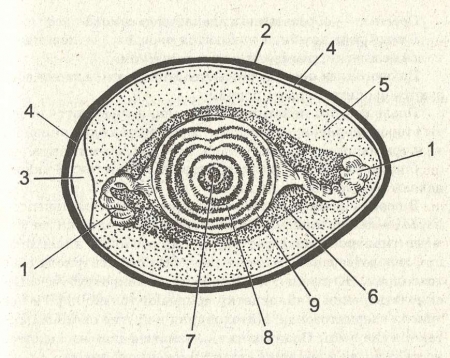The structure and functions of chromosomes. reproduction in the organic world. The structure of germ cells.
Chromosomes- cell structures that store and transmit hereditary information. A chromosome is made up of DNA and protein. The complex of proteins associated with DNA forms chromatin. Proteins play an important role in the packaging of DNA molecules in the nucleus.
DNA in chromosomes is packed in such a way that it fits in the nucleus, the diameter of which usually does not exceed 5 microns (5-10 -4 cm). The packaging of DNA takes the form of a looped structure, similar to amphibian lampbrush chromosomes or insect polytene chromosomes. The loops are maintained by proteins that recognize specific nucleotide sequences and bring them closer together. The structure of the chromosome is best seen in the metaphase of mitosis.
The chromosome is a rod-shaped structure and consists of two sister chromatids, which are held by the centromere in the region of the primary constriction. Each chromatid is made up of chromatin loops. Chromatin does not replicate. Only DNA is replicated.
Rice. 14. The structure and replication of the chromosome
When DNA replication starts, RNA synthesis stops. Chromosomes can be in two states: condensed (inactive) and decondensed (active).
The diploid set of chromosomes in an organism is called a karyotype. Modern research methods make it possible to determine each chromosome in the karyotype. For this, the distribution of light and dark bands visible under a microscope (alternation of AT and GC pairs) in chromosomes treated with special dyes is taken into account. The chromosomes of representatives of different species have transverse striation. In related species, for example, in humans and chimpanzees, the pattern of alternation of bands in the chromosomes is very similar.
Each species of organisms has a constant number, shape and composition of chromosomes. The human karyotype has 46 chromosomes - 44 autosomes and 2 sex chromosomes. Males are heterogametic (XY) and females are homogametic (XX). The Y chromosome differs from the X chromosome in the absence of certain alleles (for example, the blood clotting allele). Chromosomes of one pair are called homologous. Homologous chromosomes at the same loci carry allelic genes.
1.14. Reproduction in the organic world
reproduction- this is the reproduction of genetically similar individuals of a given species, ensuring the continuity and succession of life.
asexual reproduction carried out in the following ways:
- simple division into two or many cells at once (bacteria, protozoa);
- vegetatively (plants, coelenterates);
- division of a multicellular body in half, followed by regeneration (starfish, hydra);
- budding (bacteria, coelenterates);
- dispute formation.
Asexual reproduction usually provides an increase in the number of genetically homogeneous offspring. But when spore nuclei are produced by meiosis, the offspring from asexual reproduction will be genetically different.
sexual reproduction A process in which genetic information from two individuals is combined.
Individuals of different sexes form gametes. Females produce eggs, males produce sperm, and bisexual individuals (hermaphrodites) produce both eggs and sperm. And in some algae, two identical germ cells merge.
Fusion of haploid gametes results in fertilization and the formation of a diploid zygote.
The zygote develops into a new individual.
All of the above is true only for eukaryotes. Prokaryotes also have a sexual process, but it happens differently.
Thus, during sexual reproduction, the genomes of two different individuals of the same species are mixed. Offspring carry new genetic combinations that distinguish them from their parents and from each other.
One of the types of sexual reproduction is parthenogenesis, or the development of individuals from an unfertilized egg (aphids, drone bees, etc.).
The structure of germ cells
Oocytes- round, relatively large, motionless cells. Sizes - from 100 microns to several centimeters in diameter. They contain all the organelles characteristic of a eukaryotic cell, as well as the inclusion of reserve nutrients in the form of a yolk. The ovum is covered with an egg membrane, consisting mainly of glycoproteins.

Rice. 15. The structure of a bird's egg: 1 - chalaza; 2 - shell; 3 - air chamber; 4 - outer shell shell; 5 - liquid protein; 6 - dense protein; 7 - germinal disk; 8 - light yolk; 9 - dark yolk.
In mosses and ferns, eggs develop in archegonia, in flowering plants - in ovules localized in the ovary of the flower.
Oocytes are classified as follows:
- isolecithal - the yolk is evenly distributed and there is not much of it (in worms, mollusks);
- alecithal - almost devoid of yolk (mammals);
- telolecital - contain a lot of yolk (fish, birds);
- polylecital - contain a significant amount of yolk.
Ovogenesis is the production of eggs in females.
In the breeding zone are ovogonia - primary germ cells that reproduce by mitosis.
From the ogonium after the first meiotic division, oocytes of the first order are formed.
After the second meiotic division, second-order oocytes are formed, from which one egg and three directional bodies are formed, which then die.
spermatozoa- small, mobile cells. They have a head, neck and tail.
In front of the head is the acrosomal apparatus - an analogue of the Golgi apparatus. It contains an enzyme (hyaluronidase) that dissolves the shell of the egg during fertilization. The neck contains centrioles and mitochondria. The flagella are made up of microtubules. During fertilization, only the nucleus and centrioles of the sperm enter the egg. Mitochondria and other organelles remain outside. Therefore, cytoplasmic heredity in humans is transmitted only through the female line.
The sex cells of sexually reproducing animals and plants are formed as a result of a process called gametogenesis.
